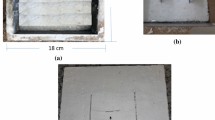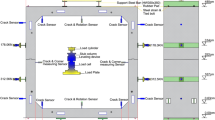Abstract
This paper investigates different configuration of the room and pillar under uniaxial loading using experimental and particle flow code in two dimension (PFC2D). Dimensions of prepared concrete specimens were chosen as 150 mm × 150 mm × 50 mm and rooms and pillars with different configurations were prepared within the specimens. The rooms dimensions were selected as 10 mm*10 mm and the pillars dimensions were determined based on rooms configuration. 12 different configurations were chosen for rooms and pillars. The tensile strength of material and the rate of axial load were 1 MPa and 0.05 mm/min, respectively. The results indicated that the failure process was affected by the pillar configuration, significantly and failure mechanism of the pillars was depended on the compressive strength of the samples, substantially. Besides, It was demonstrated that number of the induced tensile cracks affected the shear behaviour of pillars and are increased by increasing the rooms’ angles. Also, by increasing the rooms angle, the models strength is increased. The failure pattern and failure strength are similar in both approaches.













Similar content being viewed by others
Data Availability
Enquiries about data availability should be directed to the authors.
References
Bieniawski Z (1968) The effect of specimen size on compressive strength of coal. Int J Rock Mech Min Sci Geomech Abstracts 5:325–335
Bieniawski ZT (1974) Estimating the strength of rock materials, National Mechanical Engineering Research Institute, Council for Scientific and Industrial Research
Bieniawski Z, Vogler U (1969) Load-deformation behaviour of coal after failure. National Mechanical Engineering Research Institute, Council for Scientific and Industrial Research
Brauner G (1994) Rockbursts in coal mines and their prevention, AA Balkema
Cording EJ, Hashash YMA, Oh J (2015) Analysis of pillar stability of mined gas storage caverns in shale formations. Eng Geol 184:71–80
Das M (1986) Influence of width/height ratio on post-failure behaviour of coal. Int J Min Geol Eng 4:79–87
Esterhuizen GS, Dolinar DR, Ellenberger JL (2011) Pillar strength in underground stone mines in the United States. Int J Rock Mech Min Sci 48:42–50
Gaede O, Schrank C, Canbulat I, Karrech A (2014) A strain-based failure criterion for pillar stability analysis, Proceedings AusRock 2014: Third Australasian ground control in mining conference, The Australasian institute of mining and metallurgy
Galvin J (2016) Ground engineering-principles and practices for underground coal mining. Springer, Berlin
Galvin JM (2016b) Ground engineering-principles and practices for underground coal mining. Springer, Berlin
Gates R, Gauna M, Morley T, O’Donnell J Jr, Smith G, Watkins T, Weaver C, Zelanko J (2008) Report of investigation—fatal underground coal burst accidents, august 6 and 16, 2007, crandall canyon mine, genwal resources inc, huntington, emery county, utah, Department of Labor, Mine Safety and Health Administration, ID. 472
Ghazvinian A, Sarfarazi V, Schubert W, Blumel M (2012) A study of the failure mechanism of planar non-persistent open joints using PFC2D. Rock Mech Rock Eng 45(5):677–693. https://doi.org/10.1007/s00603-012-0233-2
Holland CT (1958) Cause and occurrence of coal mine bumps, Min Eng, 994–1004
Hudson JA, Brown ET, Fairhurst C (1972) Shape of the complete stress-strain curve for rock, Stability of Rock Slopes, ASCE
Jawed M, Sinha RK, Sengupta S (2013) Chronological development in coal pillar design for bord and pillar workings: a critical appraisal. J Geol Min Res 5:1–11
Kim J (2019) Robust design of pillar arrangement for safe room-and-pillar mining method. Geotech Geol Eng 37(8):66–81
Ma HT, Wang JA, Wang YH (2012) Study on mechanics and domino effect of large-scale goaf cave-in. Safety Sci 50:689–694
Maleki H (1992) In situ pillar strength and failure mechanisms for us coal seams, Proceedings of the workshop on coal pillar mechanics and design, Pittsburgh, PA: US Department of the Interior, Bureau of Mines, IC
Mark C (2000) State-of-the-art in coal pillar design. Trans-Soc Min Metall Explor Incorp 308:123–128
Mark C, Iannacchione A (1992) Coal pillar mechanics: Theoretical models and field measurements compared, Proceedings of the Workshop on Coal Pillar Mechanics and Design. Pittsburgh, PA: US Department of the Interior, Bureau of Mines, IC
Ozbay M (1989) The stability and design of yield pillars located at shallow and moderate depths. J S Afr Inst Min Metall 89:73–79
Potyondy DO (2012) A flat-jointed bonded-particle material for hard rock. Paper presented at the 46th U.S. Rock Mechanics/Geomechanics Symposium, Chicago, USA
Potyondy DO (2015) The bonded-particle model as a tool for rock mechanics research and application: current trends and future directions. Geosyst Eng 18(1):1–28. https://doi.org/10.1080/12269328.2014.998346
Potyondy DO, Cundall PA (2004) A bonded-particle model for rock. Int J Rock Mech Min Sci 41:1329–1364
Potyondy DO (2017) Simulating perforation damage with a flat-jointed bonded-particle material. Paper presented at the 51st US Rock Mechanics/Geomechanics Symposium, San Francisco, California, USA
Poulsen BA (2010) Coal pillar load calculation by pressure arch theory and near field extraction ratio. Int J Rock Mech Min Sci 47:1158–1165
Poulsen BA, Shen B (2013) Subsidence risk assessment of decommissioned bord-and-pillar collieries. Int J Rock Mech Min Sci 60:312–320
Poulsen BA, Shen B, Williams DJ et al (2014) Strength reduction on saturation of coal and coal measures rocks with implications for coal pillar strength. Int J Rock Mech Min Sci 71:41–52
Ryder J, Ozbay M (1990) A methodology for designing pillar layouts for shallow mining, in: ISRM international symposium, international society for rock mechanics
Salamon M (1995) Modes of pillar and ribside failure – development and longwall, Strata control for coal mine design – Advanced workshop, Sydney, School of Mines, University of New South Wales
Salamon M, Oravecz K (1976) Rock mechanics in coal mining, Chamber of Mines of South Africa
Seedsman RW, Hornby P (1991) Controlled and uncontrolled pillar collapse, Department of Primary Industries and Energy
Starfield A, Wawersik W (1968) Pillars as structural components in room-and-pillar mine design, The 10th US Symposium on Rock Mechanics (USRMS), American Rock Mechanics Association
Tincelin E, Sinou P (1960) Collapse of areas worked by the small pillar method, Practical conclusions and an attempt to formulate laws for the phenomena observed, Third International Conference on Strata Control, Paris
Van der Merwe J, Madden B (2002) Rock engineering for underground coal mining, The South African Institut of Mining and Metallurgy. Special Publ Series 7:233
Van Heerden W (1975) In situ complete stress–strain characteristics of large coal specimens. J S Afr Inst Min Metall 75:207–217
Van-der-Merwe JN (2003) New pillar strength formula for South African coal. J S Afr Inst Min Metall 103:281–292
Wagner H (1974) Determination of the complete load-deformation characteristics of coal pillars, Proceedings of the third international congress on rock mechanics, national academy of sciences
Zhou ZL, Chen L, Zhao Y et al (2017a) Experimental and numerical investigation on the bearing and failure mechanism of multiple pillars under overburden. Rock Mech Rock Eng 50:995–1010
Zhou ZL, Tan LH, Cao WZ et al (2017b) Fracture evolution and failure behaviour of marble specimens containing rectangular cavities under uniaxial loading. Eng Fract Mech 184:183–201
Zhou ZL, Cai X, Ma D et al (2018a) Effects of water content on fracture and mechanical behavior of sandstone with a low clay mineral content. Eng Fract Mech 193:47–65
Zhou ZL, Cai X, Ma D et al (2018b) Dynamic tensile properties of sandstone subjected to wetting and drying cycles. Constr Build Mater 182:215–232
Zhou ZL, Zhao Y, Cao WZ et al (2018c) Dynamic response of pillar workings induced by sudden pillar recovery. Rock Mech Rock Eng 51:3075–3090
Zhou ZL, Chen L, Zhao Y et al (2018d) Experimental investigation of the progressive failure of multiple pillar–roof system. Rock Mech Rock Eng 51:1629–1636
Zipf RKJ (1999) Using a post-failure stability criterion in pillar design, Proceedings of the second international workshop on coal pillar mechanics and design, NIOSH IC 9448
Zipf RKJ, Mark C (1997) Design methods to control violent pillar failures in room-and-pillar mines. Trans Inst Min Metal-Sect A-Min Ind 106:A124–A132
Funding
The authors have not disclosed any funding.
Author information
Authors and Affiliations
Corresponding author
Ethics declarations
Conflict of interest
The authors have not any conflict of interest.
Additional information
Publisher's Note
Springer Nature remains neutral with regard to jurisdictional claims in published maps and institutional affiliations.
Rights and permissions
About this article
Cite this article
Sarfarazi, V., Fattahi, S., Asgari, K. et al. Failure Behavior of Room and Pillar with Different Room Configuration Under Uniaxial Loading Using Experimental Test and Numerical Simulation. Geotech Geol Eng 40, 2881–2896 (2022). https://doi.org/10.1007/s10706-022-02073-1
Received:
Accepted:
Published:
Issue Date:
DOI: https://doi.org/10.1007/s10706-022-02073-1




